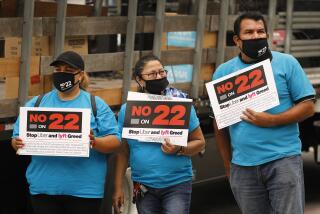Discretion of Juries Limited; 2 Sentences of Death Upheld
- Share via
SAN FRANCISCO — The California Supreme Court, sharply limiting a 1985 ruling giving jurors wider discretion in capital cases, Monday upheld the death sentences of a homosexual prostitute in two robbery-murders in San Francisco and a Ventura man convicted of killing his wife and stepson.
Over a sharp dissent, the court rejected 5 to 2 an appeal by Edgar M. Hendricks contending that his sentence must be overturned because jurors were improperly told they “shall” impose the death penalty when aggravating factors outweigh mitigating factors in a case.
The court three years ago held that such an instruction could mislead jurors and said that, if given, it also must be made clear that the jury still has discretion to vote for death only where “appropriate.”
Decision Not Reversed
On Monday, the justices did not go so far as to reverse the 1985 decision. But they upheld Hendricks’ sentence even though the controversial instruction was given and the prosecutor told jurors that the process of weighing aggravating and mitigating factors was an automatic one.
In an opinion by Chief Justice Malcolm M. Lucas, the court said the prosecutor had stopped short of telling the jury that it must impose death if aggravating factors, such as a defendant’s record, outnumber mitigating factors such as a lack of a record.
“We cannot conclude that the prosecutor ‘derailed’ the jury from an otherwise assumed proper understanding of its duty to determine appropriateness of death through the weighing process,” Lucas said.
Giving the jury too much discretion could conflict with U.S. Supreme Court decisions requiring that jurors be given specific guidelines in weighing the death penalty, he added.
In dissent, Justice Stanley Mosk, joined by Justice Allen E. Broussard, said the court majority had ignored the 1985 ruling in order to make sure the defendant “by any means” got his “just deserts.”
Mosk said he could not go along with the majority’s conclusion “even when it is applied in the case of one of society’s malefactors. The grim satisfaction of eliminating one repetitive criminal is not worth the damage to the fair and orderly administration of justice.”
State Deputy Atty. Gen. Charles R. B. Kirk praised the ruling, saying it had made a “substantial qualification” in the 1985 decision that may result in fewer reversals of other cases where the disputed instruction was given.
Prosecutors had predicted that the 1985 decision would bring about widespread reversals if applied liberally in subsequent cases.
Similarly, William M. Goodman of San Francisco, an attorney for Hendricks, said the court had eviscerated the 1985 ruling’s aim of preventing jurors from automatically returning death verdicts based on a numerical weighing of factors that might be at odds with their personal views of a case.
“The court did not come right out and reverse the (1985 ruling) but it is very difficult to see now how it could be applied to get a reversal,” he said.
Accelerated Pace
The justices, accelerating the pace of their capital rulings, now have affirmed the death penalty in eight of 12 capital cases that they have decided since a new conservative majority emerged on the court in March, 1987.
By contrast, the court had overturned 64 of 68 death penalty cases it reviewed under Chief Justice Rose Elizabeth Bird, who with two other court members was defeated by voters in November, 1986.
In each of the new court’s rulings, Lucas and four other members appointed by Gov. George Deukmejian have voted together, issuing eight affirmances and four reversals. Lucas has written the court’s opinion in eight cases.
Monday’s rulings followed three decisions last week in which the court upheld two death sentences and reversed a third. The court still faces a heavy backlog of capital cases: Of about 400 pending cases of all kinds, 194 are death penalty judgments that go to the court directly on automatic appeal.
In the first case Monday, the justices affirmed the death sentence for Hendricks in the 1980 murders of Charleston Haynes, an alleged customer in a paid sexual encounter, and James Parmer, the roommate of another reputed customer.
Earlier this year, the court in a separate case had unanimously overturned the death penalty rendered against Hendricks for the murders of two men he met on Hollywood Boulevard in Los Angeles in 1980.
In the other ruling Monday, the justices in a 6-1 decision upheld the death sentence imposed on Alejandro Gilbert Ruiz in 1981 for the first-degree murders of his fifth wife, Pauline Ruiz, and her son, Tony Mitchell.
Ruiz also was convicted of the second-degree murder of his third wife, Tanya Ruiz, who had disappeared in 1975 but whose body was never found. Included in the circumstantial evidence against Ruiz in Tanya Ruiz’s disappearance was his failure to divorce her before marrying again.
Broussard, the lone dissenter, contended that the evidence in the Tanya Ruiz case was weak and had resulted in a conviction for her death only because evidence from the two other killings had been improperly used as evidence. The failure to sever the cases unfairly increased the chances that Ruiz would receive the death penalty, Broussard said.
More to Read
Sign up for Essential California
The most important California stories and recommendations in your inbox every morning.
You may occasionally receive promotional content from the Los Angeles Times.










